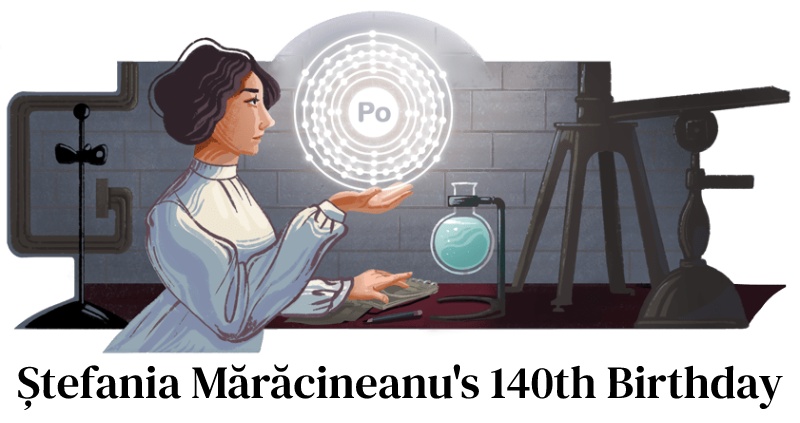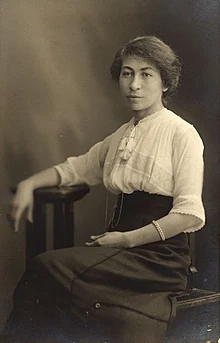News
Google Doodle celebrates Romanian pioneering female physicist’s 140th birthday; Interesting Facts about Ștefania Mărăcineanu

Google Doodle celebrates the 140th birthday of Romanian physicist Ștefania Mărăcineanu, who is one of the pioneering women in the discovery and research of radioactivity, on June 18, 2022. Here are some interesting and fun facts you should need to know about Stefania Maracineanu.

Here is a look at the life and work of Ștefania Mărăcineanu.
Personal
- Birth date: June 18, 1882
- Birthplace: Bucharest, Kingdom of Romania
- Died on: August 15, 1944 (aged 62)
- Death place: Bucharest, Kingdom of Romania
- Resting place: Bellu Cemetery
- Nationality: Romanian
- Education:
- University of Bucharest
- Radium Institute
Interesting and Fun Facts about Ștefania Mărăcineanu
Who is Stefania Maracineanu?
Ştefania Mărăcineanu was born on June 18, 1882, in Bucharest, Kingdom of Romania. She had a troubled childhood, which could have done speak, as well as this, put her seal all through her whole presence.
She finished secondary school at the Central School for Girls in her native city. In 1907 she was appointed to the University of Bucharest, acquiring her degree in physical and chemical sciences in 1910.
In 1910, Ștefania Mărăcineanu got a degree in chemical physics and soon thereafter became a teacher at Central School for girls in Bucharest, a position she held until 1940.
After World War I, with help from Constantin Kirițescu, Mărăcineanu got a partnership that permitted her to travel to Paris to further her studies.
Ștefania Mărăcineanu went for a specialization in Paris, where she worked under the leadership of Marie Curie, in The Radium Institute, and afterward in the Astronomical Observatory of Meudon; she published many papers during 1919-1930 in prestigious scientific journals.
In 1919, Stefania Maracineanu took a course on radioactivity at the Sorbonne with Marie Curie. Subsequently, she sought research with Curie at the Radium Institute until 1926. She received her Ph.D. from the Radium Institute; her thesis (which was published in 1924) was read at the French Academy’s session on June 23, 1923, by Georges Urbain.
At the Institute, Ștefania Mărăcineanu researched the half-life of polonium and devised methods of measuring alpha decay. This work led her to think that radioactive isotopes could be formed from atoms because of exposure to polonium’s alpha rays; an observation which would lead to the Joliot-Curies’ 1935 Nobel Prize.
In 1925. Ștefania Mărăcineanu was named assistant at the Faculty of Sciences in Bucharest, where she organized the first Radioactivity laboratory in Romania, performing original works in this field.
Stefania Maracineanu proceeded to work at the Paris Observatory until 1929, after which she got back to Romania, and began teaching at the University of Bucharest. She performed experiments examining the link between radioactivity and rainfall, and rainfall with earthquakes.
Ștefania Mărăcineanu dedicated her time to researching artificial rain, which incorporated a trip to Algeria to test her results. She likewise studied the link between earthquakes and rainfall, becoming the first to report that there is a significant increment of radioactivity in the epicenter leading up to an earthquake.
In 1935, Irène Currie, daughter of Marie Curie, and her husband got a joint Nobel prize for their discovery of artificial radioactivity. Mărăcineanu didn’t contest the Nobel prize, however, asked that her role in the discovery be recognized.
On 24 June 1936, Ștefania Mărăcineanu asked the Academy of Sciences to recognize the priority of her work. Her request was granted, and on 21 December 1937, she was elected the corresponding member of the Romanian Academy of Sciences, Physics section.
Ștefania Mărăcineanu’s work was perceived by the Academy of Sciences of Romania in 1936 where she was selected to act as a Director of research, yet she never received global recognition for the discovery.
In 1937, Stefania Maracineanu was named Director of Research by the Academy, and in 1941 she was elevated to Associate Professor.
In 1942, Ștefania Mărăcineanu was compulsorily retired. She died in 1944 of cancer, supposedly because of radiation exposure.
In 2013, Poșta Română issued a 1 leu anniversary stamp to honor the scientific activity of Ștefania Mărăcineanu; nonetheless, the picture on the stamp isn’t hers, but of Marie Curie.
The Curie Museum in Paris contains the original chemical lab in the Radium Institute, where Ștefania Mărăcineanu worked.
On June 18, 2022, Google Doodle honored Ștefania Mărăcineanu’s 140th birthday and pays tribute to her legacy.
-

 Business3 weeks ago
Business3 weeks agoPrakash and Kamal Hinduja: Driving Social and Environmental Change
-
Education4 weeks ago
Fred DuVal: University Leadership as a Critical Resource for Climate Change Research and Life-Saving Solutions
-

 Cryptocurrency3 weeks ago
Cryptocurrency3 weeks agoDesigned For The Masses: How Akasha (AK1111) Is Unlocking Crypto For The Next Billion Users
-

 Health3 weeks ago
Health3 weeks agoThe Hinduja Brothers Commitment to Global Health: Empowering Communities Across Borders
-

 Cryptocurrency4 weeks ago
Cryptocurrency4 weeks agoNexaglobal & Future World Token (FWT): Could This Be the Next Big Crypto Investment of 2025?
-

 Startup2 weeks ago
Startup2 weeks agoCost-Saving Strategies Every Small Business Owner Should Know to Boost Efficiency
-

 Startup3 weeks ago
Startup3 weeks agoMatthew Denegre on the Art of Deal Sourcing: Finding the Right Investment Opportunities
-

 Health2 weeks ago
Health2 weeks agoSt. John’s Community Health Examines Innovations in Pharmacy Access























